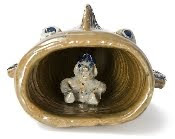 |
| Before |
 |
| After |
"The new space, seating about 140 more parishioners will be done in such a way that it will match the wonderful hand painted bead board interior finishes, new windows will match the gothic arched leaded glass windows of the old church and even the rustic pews will be matched down to every detail. It was necessary to study and profile all the existing wood trim and to be faithful to the construction techniques and joinery of the existing interior detailing. A glass connector will join the original historic structure to a new accessible lobby, restroom block and a new reconciliation room."
They wanted to grow, but first they knew who they were and what they wanted to keep.
What a wise congregation. If you start your church project thinking 'what do we want to change' you've got the order wrong. The first question is always 'what do we want to keep'. If you don't know what you want to keep, you risk losing it while you try to change.
(By ZieglerCooper Architects of Houston, Texas. See many more pictures of the renovation, including sweet parishioners moving furniture and stenciling walls, on the St. Mary's website. The state of Texas has a lovely tradition of painted churches like St. Mary's built by 19th century Czech and German immigrants.)
 |
| Before |
 |
| After |


















